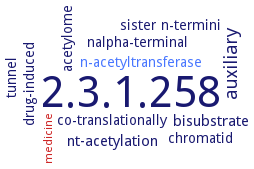2.3.1.258: N-terminal methionine Nalpha-acetyltransferase NatE
This is an abbreviated version!
For detailed information about N-terminal methionine Nalpha-acetyltransferase NatE, go to the full flat file.

Word Map on EC 2.3.1.258 
-
2.3.1.258
-
auxiliary
-
nt-acetylation
-
bisubstrate
-
n-acetyltransferase
-
n-termini
-
drug-induced
-
tunnel
-
chromatid
-
sister
-
acetylome
-
nalpha-terminal
-
co-translationally
-
medicine
- 2.3.1.258
-
auxiliary
-
nt-acetylation
-
bisubstrate
- n-acetyltransferase
-
n-termini
-
drug-induced
-
tunnel
-
chromatid
-
sister
-
acetylome
-
nalpha-terminal
-
co-translationally
- medicine
Reaction
Synonyms
ARD1, EC 2.3.1.88, hNaa50, hNatA, MtRimI, N-terminal acetyltransferase E, NAA10, NAA15, Naa50, Naa50/San, Naa50p, Naa50p (NAT5/SAN) N-terminal acetyltransferase complex, Nalpha-acetyltransferase, NAT, NAT1, NAT5, NAT5/SAN, NatA, NatA/Naa50 complex, NatE, RimI, RimI acetyltransferase, Rv3420c, SAN, ScNaa50, ScNatA, SpNaa50, SpNatA
ECTree
Advanced search results
Inhibitors
Inhibitors on EC 2.3.1.258 - N-terminal methionine Nalpha-acetyltransferase NatE
Please wait a moment until all data is loaded. This message will disappear when all data is loaded.
CoA
competitive product inhibition; product inhibition, competitive versus acetyl-CoA, noncompetitive against peptide substrate well in line with a ternary complex mechanism. The non-competitive inhibition pattern observed when CoA is tested against peptide as variable substrate and at fixed concentrations of acetyl-CoA also rules out a ping-pong mechanism
HYPK
UniProt ID Q9NX55, a protein with intrinsic NAA10 catalytic subunit inhibitory activity. HYPK and hNAA50 can bind to hNatA simultaneously to form a tetrameric hNatE/HYPK complex. hNatE displays an about 8.6fold decrease of Km, and an about 1.1fold decrease of kcat, with an overall 7.7fold increase of catalytic efficiency, compared to hNAA50. In the presence HYPK, hNatE displays an about 1.3fold decrease in Km, and an about 3.8fold decrease in kcat, with an overall 2.9fold decrease in catalytic efficiency compared to hNatE alone. The hNatE/HYPK structure reveals a negative cooperative mechanism. Over the HYPK and hNatA interaction interface within the tetrameric complex, polar interactions between HYPK-Glu74 and hNAA15-Tyr158, between the backbone carbonyl of HYPK-Thr100 and hNAA15-Lys687, between the backbone carbonyl of HYPK-Asn129 and hNAA15-Arg697, and between HYPK-Asn129 and hNAA15-Lys696 are observed
-
NAA50 and HYPK each contribute to NAA10 activity inhibition through structural alteration of the NAA10 substrate-binding site. NAA50 activity is increased through NAA15 tethering, but is inhibited by HYPK through structural alteration of the NatE substrate-binding site. hNAA50 and HYPK inhibit hNatA activity, and HYPK is dominant. The hNatE structure reveals molecular basis for enzyme crosstalk
-
additional information
-
NAA50 and HYPK each contribute to NAA10 activity inhibition through structural alteration of the NAA10 substrate-binding site. NAA50 activity is increased through NAA15 tethering, but is inhibited by HYPK through structural alteration of the NatE substrate-binding site. hNAA50 and HYPK inhibit hNatA activity, and HYPK is dominant. The hNatE structure reveals molecular basis for enzyme crosstalk
-


 results (
results ( results (
results ( top
top






